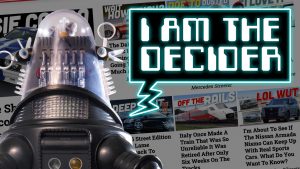Back in the mid-20th century, the German Post Office, called the Bundespost, used a metric crapton of Volkswagens, ranging from bright yellow Beetles to Type 2 vans to some Type 3 Squarebacks and then, ultimately, to the purpose-designed Typee 147 “Fridolin” – it’s just a huge mass of yellow air-cooled VWs, which makes the organization almost irresistible to me. I encountered this 1964 brochure that talks about the Bundespost’s use of VWs, and it’s full of great pictures, so let’s take a peek.
That picture up top there is incredible: that’s from 1962, and it seems to be some sort of mobile telephone switching station. There’s all kinds of fascinating details going on there, and I’m a bit surprised a telephone switching station could be wireless back then? Even with such a huge circular antenna?
The van has some interesting details, too: those doors seem to be reinforced with some extra metal bracing, and the rear engine air-intake vents seem to have been made into an open-able panel. Why? There’s also lots of extra lights tacked on, it seems, which is always fun. And so many dials and switches and gauges!

Speaking of air intake slots, this brochure also seems to have the only example I can think of of a cartoon that centers around a VW’s air-intake louvers or slots, which that fine postal-using citizen is mistaking for a mail slot. If he manages to cram that letter in there, that may cause some cooling problems! Someone should warn him!

Here’s another good example of a Type 2 outfitted to do work in the electromagnetic spectrum; this guy is listening for RF interference with that massive antenna. Maybe hunting pirate radio stations? Exciting!

Mostly, though, the Bundespost seemed to have Beetles, yellow ones, and in what I think is an appealingly basic spec. These were the low-spec 1200 Beetles, with no chrome, just painted bumpers and hubcaps, and a pretty bare-bones interior, which makes sense, as these were mail-delivery vehicles. Though they also seemed to use them for other purposes, too. Look at this:

The caption said this was a special telex-repair setup in the back of a Beetle, it looks like filling up the rear luggage well and using the location of where the folded seatback would be as a sort of flat work surface? This is extremely cool to me, with my weird fascination for Beetle luggage wells, a place I used to ride in often as a kid.
I wonder how it was to fix a telex back there? Though, to be fair, I wonder that about almost everything.
The telegraphy division seemed to be eager to show that they utilized the whole VW lineup, Types 1, 2, and 3:
And speaking of Types 1, 2, and 3, this brochure also has a page devoted to that wonderful VW Frankenstein made up of Types 1, 2, and 3 parts, the Fridolin:

I love those Fridolins, they’re so practical and friendly-looking, all sorts of qualities I seek out in my cars.
On the less friendly side, I have to give the Bundespost credit for being less averse to talking, at least obliquely, about the unpleasant side of their history. They include these pics of some WWII-era Reichspost postal box trucks, one based on a wartime Kübelwagen and one just post-war using a Beetle (I guess KdF at that point) body:

The copy suggests these were all just post-war, but just referencing it directly at all is a big deal. I know VW’s Autostadt museum/car tourist destination in Wolfsburg doesn’t acknowledge anything prior to 1950, just for reference.
Oh, and you know tha post horn that’s used as the Bundespost logo? Am I the only one who learned what the hell those are by reading The Crying of Lot 49?









Former Type 2 panel bus owner and DDer here: the louvres used in the cartoon were not open to the engine bay, and actually would have dropped into the cargo area above the parcel tray. I had mine set up for camping (as one does), and set up a set of magnetic window screen covers so I could get the ventilation without the bugs and without compromising the bodywork.
In that cartoon, the beetle driver appears to be putting the letter in the strange little vents the panel buses had that were above the engine compartment. I never really understood what these are for. You can see them in this double door bus https://www.thesamba.com/vw/archives/pressphotos/61panel_a.jpg
Those aerials and testing equipments were used to test the strength and coverage of mobile radio telephone system (called A-Netz in use from 1952 to 1980). To put things in better perspectives, the telecommunications system in Germany was managed by Deutsche Bundespost, a federal public utility agency who owned both landline and mobile telephone systems along with postal services until its 1995 privatisation.
The mobile radio telephone system were first installed by the Deutsche Bundespost in its own postal train carriages then by the Deutsche Bundesbahn (German Federal Railway) in 1955. Deutsche Bundesbahn took advantage of mobile radio telephones by offering its service to the executives, politicians, or wealthy people on the move for the exorbitant fees.
When the size of mobile radio telephones became smaller (16 kg) to fit in the passenger cars in 1954, they became popular with executives, politicians, wealthy people, taxicab drivers, and people on the move. The equipment cost twice more than VW Käfer in 1955, and monthly service fee and connection fee cost more than what the ordinary people could earn in a week.
With the landscape changing over time from the constructions of new buildings, roadways, etc., the technicians had to test the coverage and strength as to see whether the new radio transmission towers were warranted and such. Thence, those testing vans on the prowl…
I’m guessing the first image is of collecting radio wave propagation data. This used to be tested in the field to optimize before a transmission tower location would be selected. These days it’s all done by computer simulation.
Beware of Germans driving around with antennas. Just ask Hugh Laurie.
I assume the loop antenna is for direction finding, i.e. for finding a source of interference. As for the telegraphy vehicle, there are all sorts of transitory comms needs to address. After all the Belgians invented the Telex Temporary Chicken.
The engineer in the first photo had no ambition to be outstanding in his field.
He brought a chair.
Door’s over there, buddy.
Those guys are ham radio enthusiasts trying to get in touch with their friends and relatives in Argentina.
Or maybe their boys in Brazil.
I will never understand how no one thought to check the local Mercedes-Benz plant and dealerships when hunting for those runners.
Nah, this is pure Cold War stuff. They’re spying on the East Germans. Or possibly the Danes.
Is so It’d be the Danes. Spying on East Germany was too depressing.
Glorious comment. +1
Also applicable: their former schoolmate Wernher who was kidnapped by the Americans and is now in “Huntsville Alabama”.
Yeah he’s a Nazi but he’s OUR Nazi!
yeah, these were all FIS operatives posing as postmen. Antennae were for picking up the Ossi frauenliga lederball scores. It was the only way to anticipate Mielke’s moods, which indicated the number of Ossis coming over/around/under the wire in the coming week.
Postwar Germany was a very strange place.
“Hey, Gunther, take the antenna van out and do some tests so the Americans don’t think we’re trying to take over the world again.”
” I’m a bit surprised a telephone switching station could be wireless back then?”
May I introduce you to Marconi?
https://en.wikipedia.org/wiki/Guglielmo_Marconi
Wait a tick, I’ve seen that circular antenna before… Watch Out Steve Austin! That robot Major Sloan was constructed to kill!
Based on the size of that circular dipole, the antenna is designed for the VHF-high band, which we know as channels 7-13.
And the Yagi-Uda on the tall mast is definitely UHF, also looks to be in the TV band at channels 14-83.
That’s all well and good, but I’m tellin ya, you gotta knock that robots freakin face off before it’ll quit!
Did Germany have a licensing scheme for TV receivers as did Britain?
Hmm, I’m out of my depth on that one. I just like playing with antennas.
Yes, still to this day and compulsory. It’s called Rundfunkbeitrag, costing about €55.08 per household per month regardless of how many television sets and radios as well as computers and smart tablets with Internet access the household has.
There’s more and more calls to terminate Rundfunkbeitrag lately due to the state television broadcasters no longer being politically impartial and balanced as mandated in the laws and due to its fearmongering news and talk shows during the recent pandemic and toward Alternative für Deutschland (AfD).
You’re wrong. It’s 18,36 € / month, and that’s just the start, from where your post just keeps going further downhill.
Well, I happened to forget to insert “three”. No need to get so anal retentive about it.
How do you fearmonger the far right in Germany? ????
By denying the politicians from AfD to participate in the talk shows and such while giving Die Grünen, SPD, CDU/CSU, and BSW lot of air time and lot of chance to talk sewage. By working up the fear about the AfD and turning the people against the AfD as the “boogeymen” that must be banned.
The traffic light coalition has done so much destruction to the economy, security, finances, and businesses. They ignore the Grundgesetze (our “de facto” constitution) and our rights. So, why are they allowed to be “good parties” while AfD “bad party” that need to be banned?
Do I need to go on?
What has AfD done for Germany so far?
Do I need to go on?
If the public TV broadcasters have been faithfully impartial (as required), the Germans would see the truth about the legacy political parties and AfD.
AfD is German equivalent of US Republican party. So there…
Argument closed.
“AfD is German equivalent of US Republican party”
No, the AfD seems to be more of a wannabe recreation of another German party from a few decades back…
The van with the tall mast would be on its side after a 15 mph gust of wind.
You might be the only person to get that far into a Thomas Pynchon novel.
The prosecution rests.
https://youtu.be/S0LVuPQ3GdM?si=V4AyFj7RY3rfG_i8
Love the matte yellow on those beetles. They preempted wrap bros by a century pretty much.
Don’t postal agencies in many countries use some form of coach horn for their logo? I thought that was pretty standard?
It was pretty common.
Yes, I remember the Jordan F1 cars, sponsored by Deutsche Post, featured that little horn.
Perhaps unsurprisingly, LEGO does as well:
https://brickset.com/sets/6362-1/Post-Office
I’m sorry, but most of these period color photos look like something out of a Monty Python sketch and I’m having a hard time taking them seriously.
In the top shot, is that a storm brewing behind the trees to the left? Might this be some kind of weather set up?
“In the top shot, is that a storm brewing behind the trees to the left? Might this be some kind of weather-manipulation set up?”
Fixed it for you. And yes, yes it is.
A scene from the German blockbuster “Der Twister” where everyone stays a rigorously calculated safe distance from the storm and the divorce papers are signed and notarized in triplicate in a single scene that occupies the first 30 minutes of the film.
Imagine Dorothy set up in the back of a Type II Plattenwagen. Now imagine it being able to outrun the tornado like Bill Pullman’s Dodge.
Or was it Bill Paxton?
Pullman flew a winnibago. Paxton flew a Dodge.
Ooo, but Pullman also flew an F/A-18 vs the aliens, and Paxton probably drove some bigass truck when he did that Mormon show.